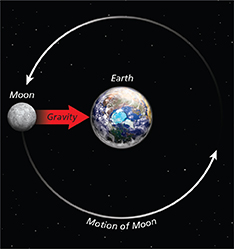Gravity Acts Over Large Distances
The gravitational force between two objects is proportional to their masses and decreases rapidly as the distance between the masses increases. The greater the mass of the objects, the greater is the gravitational force. Gravitational force decreases with the square of the distance between the objects. As shown in Figures 21A and 21C, if the distance between masses doubles, the force of gravity is only one fourth as strong.
Gravity is the weakest universal force, but it is the most effective force over long distances. Gravity holds you on Earth. It keeps the moon in orbit around Earth, the planets in orbit around the sun, and the stars in orbit in their galaxies. The sun's mass is about 300,000 times the mass of Earth, so the sun's gravitational force is much stronger than that of Earth. The influence of the sun's gravitational force extends well beyond Earth. Pluto, which is almost 40 times farther from the sun than Earth is, has its orbit determined by the gravitational pull of the sun.
The Earth, Moon, and Tides
How is the moon kept in orbit around Earth? Recall that the moon has inertia, so according to Newton's first law, it should continue to move along a straight path until acted upon by a force. That force is Earth's gravitational force, which acts continuously to pull the moon toward it, as shown in Figure 22.
Earth's gravitational attraction keeps the moon in an elliptical orbit around Earth. It works in much the same way that a string tied to an eraser allows you to twirl the eraser in a circle over your head. As you twirl the eraser, the string exerts a centripetal force on the eraser. A centripetal force is a center-directed force that continuously changes the direction of an object to make it move around the center. This center-directed force causes a continuous change in the direction of the eraser. In a similar way, the center-directed force of Earth's gravity pulls the moon into an elliptical orbit around Earth.
If you have spent time at the seashore, you have probably noticed that the level of the tide changes throughout the day. The gravitational pull from the moon produces two bulges in Earth's oceans. One bulge is on the side of Earth closest to the moon. The other bulge is on the side of Earth farthest from the moon. Earth rotates once per day beneath theses two bulges. This rotation results in two high and two low tides per day on Earth.

Figure 22 The moon's inertia and the gravitational pull of Earth result in an elliptical orbit. The gravitational pull of the moon is the primary cause of Earth's ocean tides.






